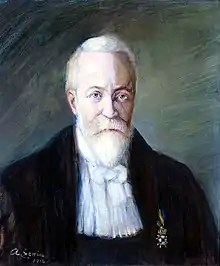Willem Henri Julius
Willem Henri Julius (4 August 1860 – 15 April 1925) was a Dutch physicist who specialised in the study of solar radiation and related phenomena. A careful experimenter, he designed several instruments for the measurement of radiation.

Julius was born in Zutphen son of a namesake school teacher and his wife Maria Margaretha Dumont. After studying at Gouda, he entered the University of Utrecht in 1875. He became an assistant to C. H. D. Buys Ballot in 1882 and in 1888 he worked with an uncle who was also a physicist. In 1888 he wrote a doctoral dissertation on the spectra from flames and the vibrational frequencies of some gases under Buys Ballot. He taught in Utrecht before joining the University of Amsterdam in 1890. In 1896 he became a professor at Utrecht University. In 1901 he conducted observations during the solar eclipse and from on became completely immersed in the study of solar radiation. He examined anomalous scattering and its relation to differences in redshift in the spectra of rays at the prominences and at the centre of the solar disk. He explained the increase in the redshift from the centre to the edge as being due to dispersion by the solar atmosphere[1] rather than as Einstein who interpreted it as being due to gravitational effects.[2]
References
- Taltavull, Marta Jordi (2020). "Rudolf Ladenburg and the first quantum interpretation of optical dispersion". The European Physical Journal H. 45 (2–3): 123–173. doi:10.1140/epjh/e2020-10027-6. ISSN 2102-6459.
- Snelders, H.A.M. (2013). "Julius, Willem Henri (1860-1925)". Biografisch Woordenboek van Nederland (in Dutch). Amsterdam: Huygens Instituut.